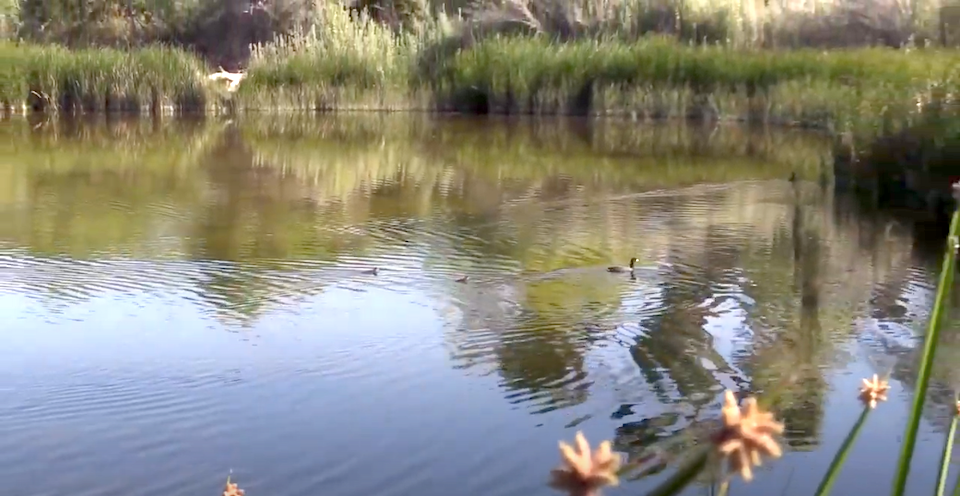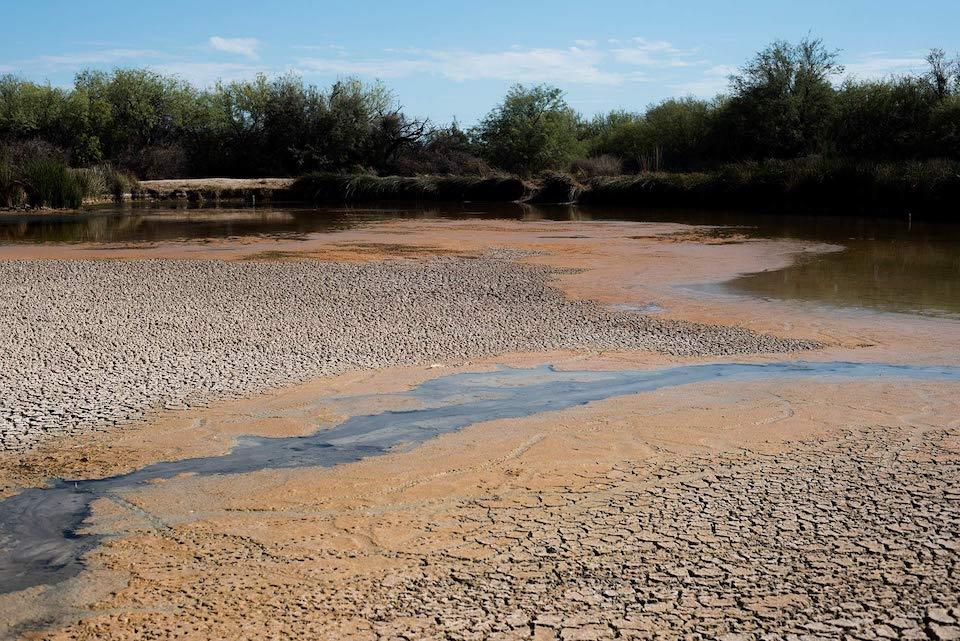
Quitobaquito pond during better times/Patrick Cone file
Quitobaquito Springs long has shimmered as a small but vital oasis in the southwestern corner of Organ Pipe Cactus National Monument in Arizona. This small pool surrounded by the prickly Sonoran Desert landscape has been drawing thirsty travelers for centuries, and no doubt has many stories to tell.
The latest story is that construction of the border wall between the United States and Mexico might be doing considerable harm to the springs, which could be on the doorstep of ecological collapse because of the construction.
When I visited Quitobaquito back in May 2017 with Patrick Cone, Traveler's special projects editor, the vegetation rimming the small pond was lush and filled with singing birds and buzzing insects. Rivulets streaming down the nearby hillsides to the pool of water were alive with schools of little blue fish—the Sonoyta pupfish, also known as the Quitobaquito pupfish.
Listed as endangered under the Endangered Species Act, these warm-water fish are thought to exist nowhere else outside the monument.
Visit Quitobaquito now, and you might be greeted by cracked mudflats on the floor of the pond. A group of 25 scientists -- ecologists, hydrologists, botanists and archaeologists -- maintains the setting is the result of work by the U.S. Army Corps of Engineers as it goes about building the wall.

This is how Quitobaquito pond appeared on July 18, 2020/Alisa Reznick, Arizona Public Media
"The agency’s construction of the border wall has precipitated groundwater overdraft and rock fracturing by dynamite that have dramatically dried up springs and degraded critical habitat for endangered species over the last four months," they wrote last week in a letter asking the federal government to stop the construction.
"Quitobaquito is facing an unprecedented crisis. In less than three months, the flow rates of the remaining springs at Quitobaquito have fallen by 44 percent, from 10.65 gallons per minute in March, to below 6 gallons per minute by July 15th, the lowest level on record," they wrote in the letter. "In the 1990s, flow rates were around 30 gallons per minute. We estimate that the pond level has dropped 15 inches in the last three to four months, leaving 15 to 20 percent of the former pond surface as mudflats, and 60 percent to 75 percent of the remaining pond with less than a foot of water above the mud, algae, and aquatic plants on the bottom."
The loss of water has led to a loss of migratory waterfowl and wading birds, they said, and the rivulets that come down the hillsides are vanishing.
"Only two of the spring flows from the hill above the oasis run more than 50 feet; four others are now small seeps with no above-ground flow; and the rest of the ancient springs have no standing surface water."
According to the scientists, the National Park Service at Organ Pipe has been "shunting all spring flows directly into an almost sterile, lined pond to save endangered desert pupfish and Sonoran mud turtles. But the Park Service should not dismiss the need to sustain the riparian and semi-aquatic plants that provide wildlife and fish with shade, nutrients, insect foods and other resources they depend upon for survival."
Kevin Dahl, the National Parks Conservation Association's Arizona senior program manager, was optimistic Friday that the situation can be reversed.
"It is shocking and sad to see Quitobaquito pond – a true desert oasis that supports several endangered species – so dry. Apparently a hole in the clay layers at the bottom of the pond caused it to shrink rapidly," he said in an email. "While it looks bad now, and this has been compounded by a troublesome delay in summer rains, I am confident that National Park Service and U.S. Fish and Wildlife Service restoration efforts will stop the damage and their work will enable the pond to return."
Still, Dahl said, "(I)t is hard not to conclude that the use of heavy machinery to construct Trump’s unneeded border wall almost adjacent to the pond has something to do with the leak that caused this. I personally saw bulldozers and other earth-moving equipment scrap a swath of desert and riparian vegetation way too close to the pond."
"The fact is that the Department of Homeland Security waived dozen of laws thus preventing needed studies and public involvement before building a wall in this sensitive location," he added. "More than a thousand scientists and conservation leaders signed a petition months before wall construction reached Quitobaquito asking that other security measures be used here. A massive one-size-fits-all wall is bound to impact this fragile and rare location, in addition to stopping wildlife connectivity and interfering with traditional Native American practices.
"The pond drying up is emblematic of the needless damage being done by this unnecessary, expensive, and ultimately ineffective campaign-promise project."



Comments
I like this website - it was thanks to you that we were able to see Glacier when it opened in July. But this kind of political stuff is why I don't donate.
The building of the wall and its possible effect on the environment is an important story. But you just have to include: "Trump's unneeded wall".
Mike, unfortunately, politics are tied to just about everything in the world it seems, and certainly to the National Park Service and National Park System. There are strong opinions, and they're not limited to the current administration.
The Obama administration drew condemnation for a number of things:
* Its decision to allow a utility to enlarge its transmission corridor through a slice of the Delaware Water Gap National Recreation Area, through the Middle Delaware National Scenic River, and across the Appalachian National Scenic Trail.
* Its decision to remove Endangered Species Act protections from wolves in most of Wyoming.
* The Park Service's decision not to designate official wilderness within the "Addition Lands" of Big Cypress but rather open the landscape to upwards of 130 miles of off-road vehicle routes and hunting.
* Efforts by the U.S. Fish and Wildlife Service to delist grizzly bears in the Greater Yellowstone Ecosystem.
* The administration drew criticism for proposing to build solar energy plantations uncomfortably close to the park system.
* The Obama adminstration was even criticized for failing to develop a centennial celebration for the National Park Service that included a strong conservation initiative.
There are more examples, but you get the idea.
We include politics in our coverage of the parks because politicians can pull the parks in directions that might not be the best for the National Park System, and the general public needs to be aware of how the parks are being managed.
Thanks for replying. How government policy might effect NPS and the environment is definitely fair game.
Because it is an uneeded wall. it is Trumps attempt at legacy. It's going to be legacy all right, but not in the way he envisioned. His administration has been nothing short of openly hostile to the environmental impacts of land management, not just this project, but hundreds of projects destroying nattional treasures that will never be recovered.
Agree Bill, the wall isn't needed. All we need is to deny illegals schooling, jobs, welfare and any thing short of emergency healthcare. But then, I suspect you wouldn't go for that either so that leaves us with a wall. A wall that the Democrats wanted before Trump became President. A wall that has nothing to do with Trumps legacy but rather with the integrity of our boarders.
By the way, here is a more comprehensive review that suggests this is hardly unprecidented and indicates the pond was man made and didn't even exist until the 1860s.
https://tucson.com/news/local/rare-watering-hole-near-border-wall-southw...
I went to Yosemite during the Obama administration and the tour bus driver told us things were much better under Obama than they had been under Bush. Specifically they received more support and I am sure the case is the same for Trump.
What makes you so certain that positive things started under Obama have continued for the past four years under Trump? Empiracle evidence would seem to support the exact opposite - that Trump wants to eliminate anything positive from Obama.